Destination Planning and Development
VerifiedAdded on 2022/12/30
|8
|2926
|91
AI Summary
This report provides an overview of destination planning and development in the tourism industry, focusing on Rome, Italy. It discusses the key traits of the millennial travel market, the success of tourism in Rome, and the 3 key A's Audit. It also highlights the challenges of a proposed product in the restaurant industry.
Contribute Materials
Your contribution can guide someone’s learning journey. Share your
documents today.
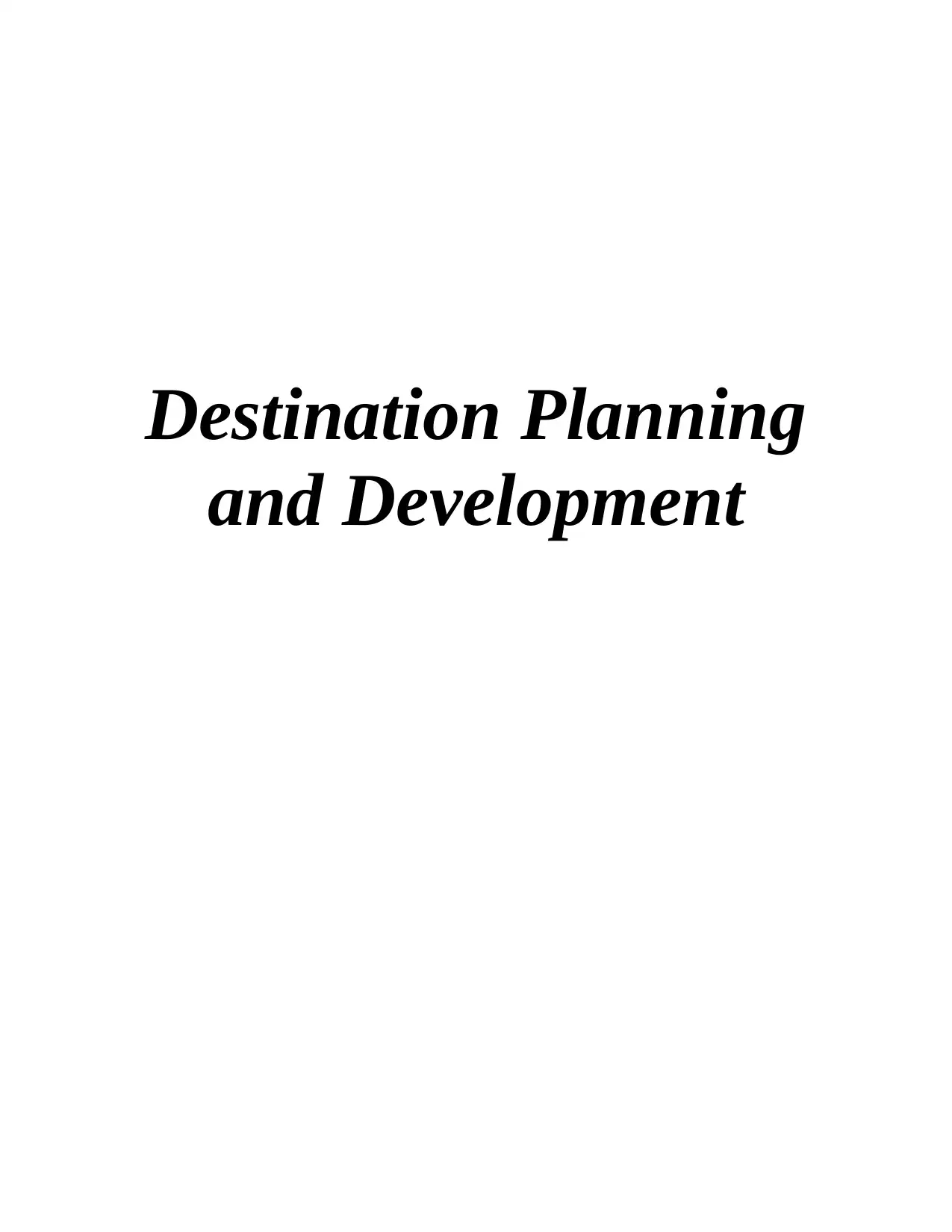
Destination Planning
and Development
and Development
Secure Best Marks with AI Grader
Need help grading? Try our AI Grader for instant feedback on your assignments.
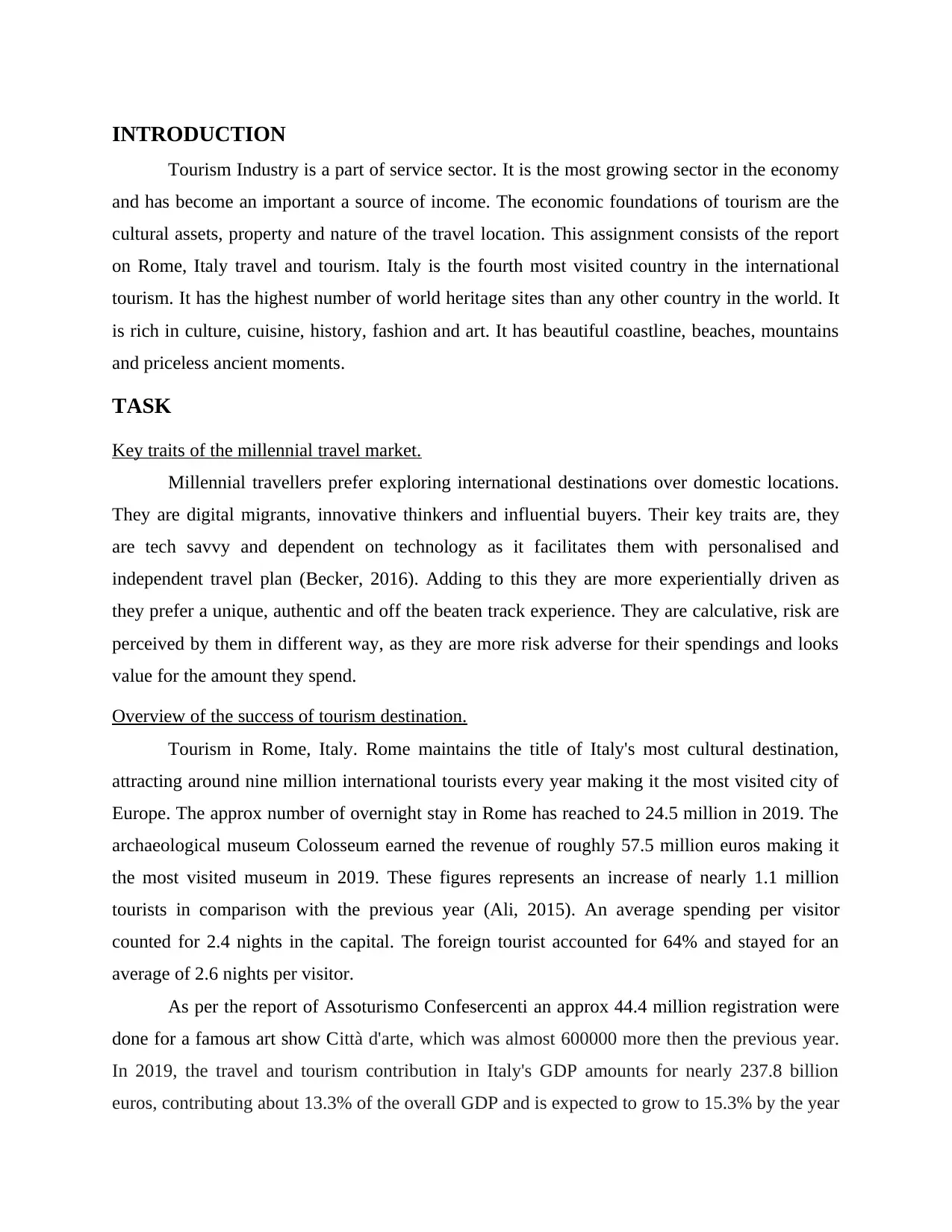
INTRODUCTION
Tourism Industry is a part of service sector. It is the most growing sector in the economy
and has become an important a source of income. The economic foundations of tourism are the
cultural assets, property and nature of the travel location. This assignment consists of the report
on Rome, Italy travel and tourism. Italy is the fourth most visited country in the international
tourism. It has the highest number of world heritage sites than any other country in the world. It
is rich in culture, cuisine, history, fashion and art. It has beautiful coastline, beaches, mountains
and priceless ancient moments.
TASK
Key traits of the millennial travel market.
Millennial travellers prefer exploring international destinations over domestic locations.
They are digital migrants, innovative thinkers and influential buyers. Their key traits are, they
are tech savvy and dependent on technology as it facilitates them with personalised and
independent travel plan (Becker, 2016). Adding to this they are more experientially driven as
they prefer a unique, authentic and off the beaten track experience. They are calculative, risk are
perceived by them in different way, as they are more risk adverse for their spendings and looks
value for the amount they spend.
Overview of the success of tourism destination.
Tourism in Rome, Italy. Rome maintains the title of Italy's most cultural destination,
attracting around nine million international tourists every year making it the most visited city of
Europe. The approx number of overnight stay in Rome has reached to 24.5 million in 2019. The
archaeological museum Colosseum earned the revenue of roughly 57.5 million euros making it
the most visited museum in 2019. These figures represents an increase of nearly 1.1 million
tourists in comparison with the previous year (Ali, 2015). An average spending per visitor
counted for 2.4 nights in the capital. The foreign tourist accounted for 64% and stayed for an
average of 2.6 nights per visitor.
As per the report of Assoturismo Confesercenti an approx 44.4 million registration were
done for a famous art show Città d'arte, which was almost 600000 more then the previous year.
In 2019, the travel and tourism contribution in Italy's GDP amounts for nearly 237.8 billion
euros, contributing about 13.3% of the overall GDP and is expected to grow to 15.3% by the year
Tourism Industry is a part of service sector. It is the most growing sector in the economy
and has become an important a source of income. The economic foundations of tourism are the
cultural assets, property and nature of the travel location. This assignment consists of the report
on Rome, Italy travel and tourism. Italy is the fourth most visited country in the international
tourism. It has the highest number of world heritage sites than any other country in the world. It
is rich in culture, cuisine, history, fashion and art. It has beautiful coastline, beaches, mountains
and priceless ancient moments.
TASK
Key traits of the millennial travel market.
Millennial travellers prefer exploring international destinations over domestic locations.
They are digital migrants, innovative thinkers and influential buyers. Their key traits are, they
are tech savvy and dependent on technology as it facilitates them with personalised and
independent travel plan (Becker, 2016). Adding to this they are more experientially driven as
they prefer a unique, authentic and off the beaten track experience. They are calculative, risk are
perceived by them in different way, as they are more risk adverse for their spendings and looks
value for the amount they spend.
Overview of the success of tourism destination.
Tourism in Rome, Italy. Rome maintains the title of Italy's most cultural destination,
attracting around nine million international tourists every year making it the most visited city of
Europe. The approx number of overnight stay in Rome has reached to 24.5 million in 2019. The
archaeological museum Colosseum earned the revenue of roughly 57.5 million euros making it
the most visited museum in 2019. These figures represents an increase of nearly 1.1 million
tourists in comparison with the previous year (Ali, 2015). An average spending per visitor
counted for 2.4 nights in the capital. The foreign tourist accounted for 64% and stayed for an
average of 2.6 nights per visitor.
As per the report of Assoturismo Confesercenti an approx 44.4 million registration were
done for a famous art show Città d'arte, which was almost 600000 more then the previous year.
In 2019, the travel and tourism contribution in Italy's GDP amounts for nearly 237.8 billion
euros, contributing about 13.3% of the overall GDP and is expected to grow to 15.3% by the year
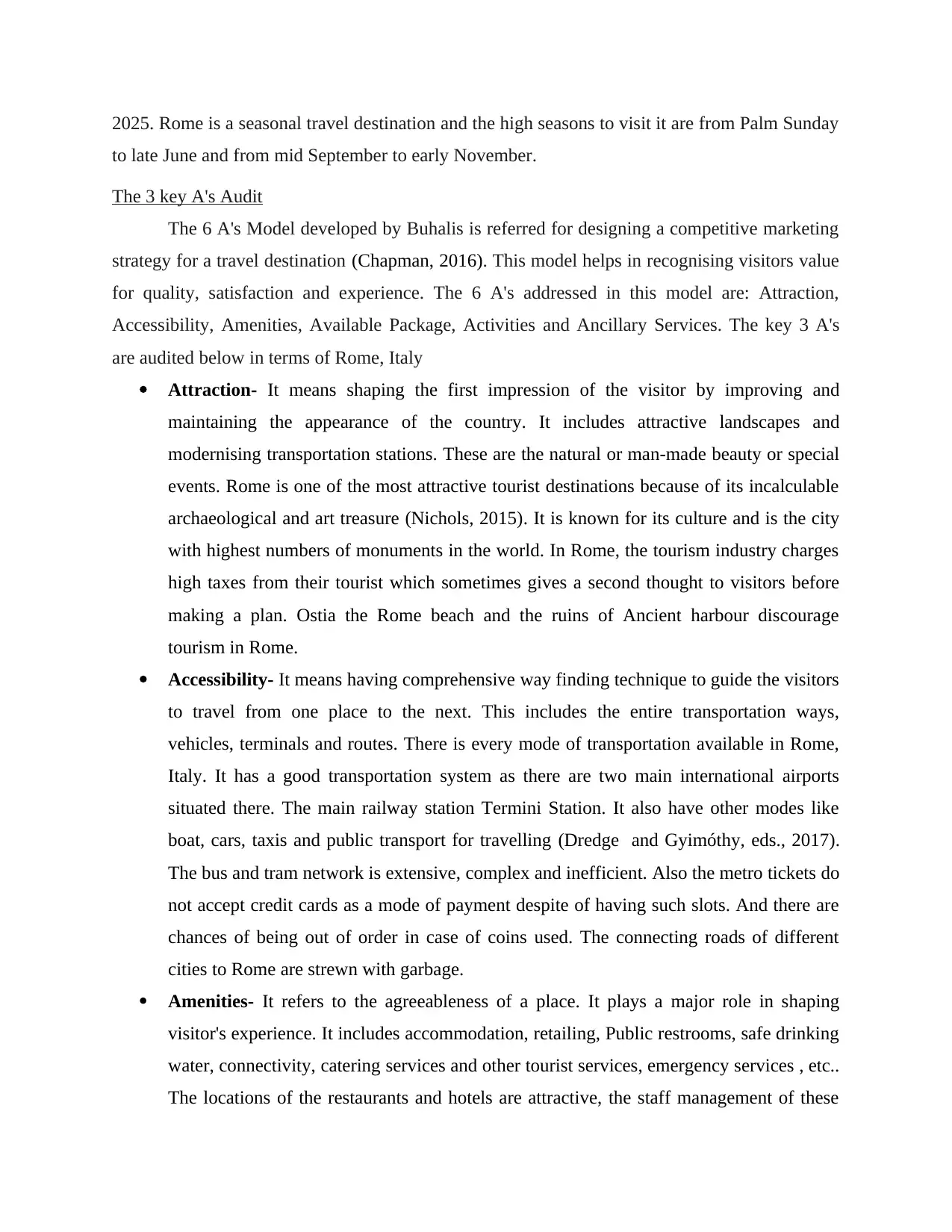
2025. Rome is a seasonal travel destination and the high seasons to visit it are from Palm Sunday
to late June and from mid September to early November.
The 3 key A's Audit
The 6 A's Model developed by Buhalis is referred for designing a competitive marketing
strategy for a travel destination (Chapman, 2016). This model helps in recognising visitors value
for quality, satisfaction and experience. The 6 A's addressed in this model are: Attraction,
Accessibility, Amenities, Available Package, Activities and Ancillary Services. The key 3 A's
are audited below in terms of Rome, Italy
Attraction- It means shaping the first impression of the visitor by improving and
maintaining the appearance of the country. It includes attractive landscapes and
modernising transportation stations. These are the natural or man-made beauty or special
events. Rome is one of the most attractive tourist destinations because of its incalculable
archaeological and art treasure (Nichols, 2015). It is known for its culture and is the city
with highest numbers of monuments in the world. In Rome, the tourism industry charges
high taxes from their tourist which sometimes gives a second thought to visitors before
making a plan. Ostia the Rome beach and the ruins of Ancient harbour discourage
tourism in Rome.
Accessibility- It means having comprehensive way finding technique to guide the visitors
to travel from one place to the next. This includes the entire transportation ways,
vehicles, terminals and routes. There is every mode of transportation available in Rome,
Italy. It has a good transportation system as there are two main international airports
situated there. The main railway station Termini Station. It also have other modes like
boat, cars, taxis and public transport for travelling (Dredge and Gyimóthy, eds., 2017).
The bus and tram network is extensive, complex and inefficient. Also the metro tickets do
not accept credit cards as a mode of payment despite of having such slots. And there are
chances of being out of order in case of coins used. The connecting roads of different
cities to Rome are strewn with garbage.
Amenities- It refers to the agreeableness of a place. It plays a major role in shaping
visitor's experience. It includes accommodation, retailing, Public restrooms, safe drinking
water, connectivity, catering services and other tourist services, emergency services , etc..
The locations of the restaurants and hotels are attractive, the staff management of these
to late June and from mid September to early November.
The 3 key A's Audit
The 6 A's Model developed by Buhalis is referred for designing a competitive marketing
strategy for a travel destination (Chapman, 2016). This model helps in recognising visitors value
for quality, satisfaction and experience. The 6 A's addressed in this model are: Attraction,
Accessibility, Amenities, Available Package, Activities and Ancillary Services. The key 3 A's
are audited below in terms of Rome, Italy
Attraction- It means shaping the first impression of the visitor by improving and
maintaining the appearance of the country. It includes attractive landscapes and
modernising transportation stations. These are the natural or man-made beauty or special
events. Rome is one of the most attractive tourist destinations because of its incalculable
archaeological and art treasure (Nichols, 2015). It is known for its culture and is the city
with highest numbers of monuments in the world. In Rome, the tourism industry charges
high taxes from their tourist which sometimes gives a second thought to visitors before
making a plan. Ostia the Rome beach and the ruins of Ancient harbour discourage
tourism in Rome.
Accessibility- It means having comprehensive way finding technique to guide the visitors
to travel from one place to the next. This includes the entire transportation ways,
vehicles, terminals and routes. There is every mode of transportation available in Rome,
Italy. It has a good transportation system as there are two main international airports
situated there. The main railway station Termini Station. It also have other modes like
boat, cars, taxis and public transport for travelling (Dredge and Gyimóthy, eds., 2017).
The bus and tram network is extensive, complex and inefficient. Also the metro tickets do
not accept credit cards as a mode of payment despite of having such slots. And there are
chances of being out of order in case of coins used. The connecting roads of different
cities to Rome are strewn with garbage.
Amenities- It refers to the agreeableness of a place. It plays a major role in shaping
visitor's experience. It includes accommodation, retailing, Public restrooms, safe drinking
water, connectivity, catering services and other tourist services, emergency services , etc..
The locations of the restaurants and hotels are attractive, the staff management of these
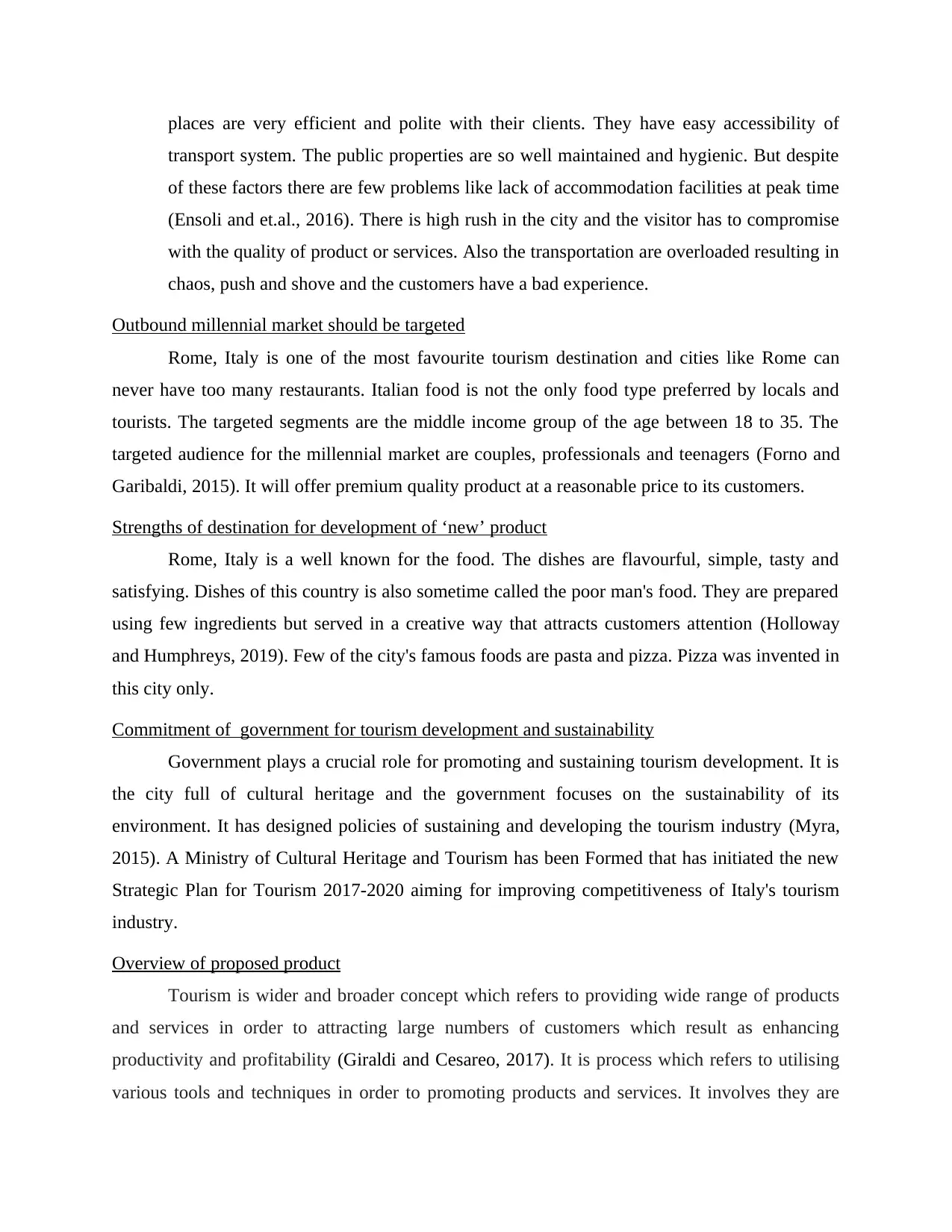
places are very efficient and polite with their clients. They have easy accessibility of
transport system. The public properties are so well maintained and hygienic. But despite
of these factors there are few problems like lack of accommodation facilities at peak time
(Ensoli and et.al., 2016). There is high rush in the city and the visitor has to compromise
with the quality of product or services. Also the transportation are overloaded resulting in
chaos, push and shove and the customers have a bad experience.
Outbound millennial market should be targeted
Rome, Italy is one of the most favourite tourism destination and cities like Rome can
never have too many restaurants. Italian food is not the only food type preferred by locals and
tourists. The targeted segments are the middle income group of the age between 18 to 35. The
targeted audience for the millennial market are couples, professionals and teenagers (Forno and
Garibaldi, 2015). It will offer premium quality product at a reasonable price to its customers.
Strengths of destination for development of ‘new’ product
Rome, Italy is a well known for the food. The dishes are flavourful, simple, tasty and
satisfying. Dishes of this country is also sometime called the poor man's food. They are prepared
using few ingredients but served in a creative way that attracts customers attention (Holloway
and Humphreys, 2019). Few of the city's famous foods are pasta and pizza. Pizza was invented in
this city only.
Commitment of government for tourism development and sustainability
Government plays a crucial role for promoting and sustaining tourism development. It is
the city full of cultural heritage and the government focuses on the sustainability of its
environment. It has designed policies of sustaining and developing the tourism industry (Myra,
2015). A Ministry of Cultural Heritage and Tourism has been Formed that has initiated the new
Strategic Plan for Tourism 2017-2020 aiming for improving competitiveness of Italy's tourism
industry.
Overview of proposed product
Tourism is wider and broader concept which refers to providing wide range of products
and services in order to attracting large numbers of customers which result as enhancing
productivity and profitability (Giraldi and Cesareo, 2017). It is process which refers to utilising
various tools and techniques in order to promoting products and services. It involves they are
transport system. The public properties are so well maintained and hygienic. But despite
of these factors there are few problems like lack of accommodation facilities at peak time
(Ensoli and et.al., 2016). There is high rush in the city and the visitor has to compromise
with the quality of product or services. Also the transportation are overloaded resulting in
chaos, push and shove and the customers have a bad experience.
Outbound millennial market should be targeted
Rome, Italy is one of the most favourite tourism destination and cities like Rome can
never have too many restaurants. Italian food is not the only food type preferred by locals and
tourists. The targeted segments are the middle income group of the age between 18 to 35. The
targeted audience for the millennial market are couples, professionals and teenagers (Forno and
Garibaldi, 2015). It will offer premium quality product at a reasonable price to its customers.
Strengths of destination for development of ‘new’ product
Rome, Italy is a well known for the food. The dishes are flavourful, simple, tasty and
satisfying. Dishes of this country is also sometime called the poor man's food. They are prepared
using few ingredients but served in a creative way that attracts customers attention (Holloway
and Humphreys, 2019). Few of the city's famous foods are pasta and pizza. Pizza was invented in
this city only.
Commitment of government for tourism development and sustainability
Government plays a crucial role for promoting and sustaining tourism development. It is
the city full of cultural heritage and the government focuses on the sustainability of its
environment. It has designed policies of sustaining and developing the tourism industry (Myra,
2015). A Ministry of Cultural Heritage and Tourism has been Formed that has initiated the new
Strategic Plan for Tourism 2017-2020 aiming for improving competitiveness of Italy's tourism
industry.
Overview of proposed product
Tourism is wider and broader concept which refers to providing wide range of products
and services in order to attracting large numbers of customers which result as enhancing
productivity and profitability (Giraldi and Cesareo, 2017). It is process which refers to utilising
various tools and techniques in order to promoting products and services. It involves they are
Secure Best Marks with AI Grader
Need help grading? Try our AI Grader for instant feedback on your assignments.
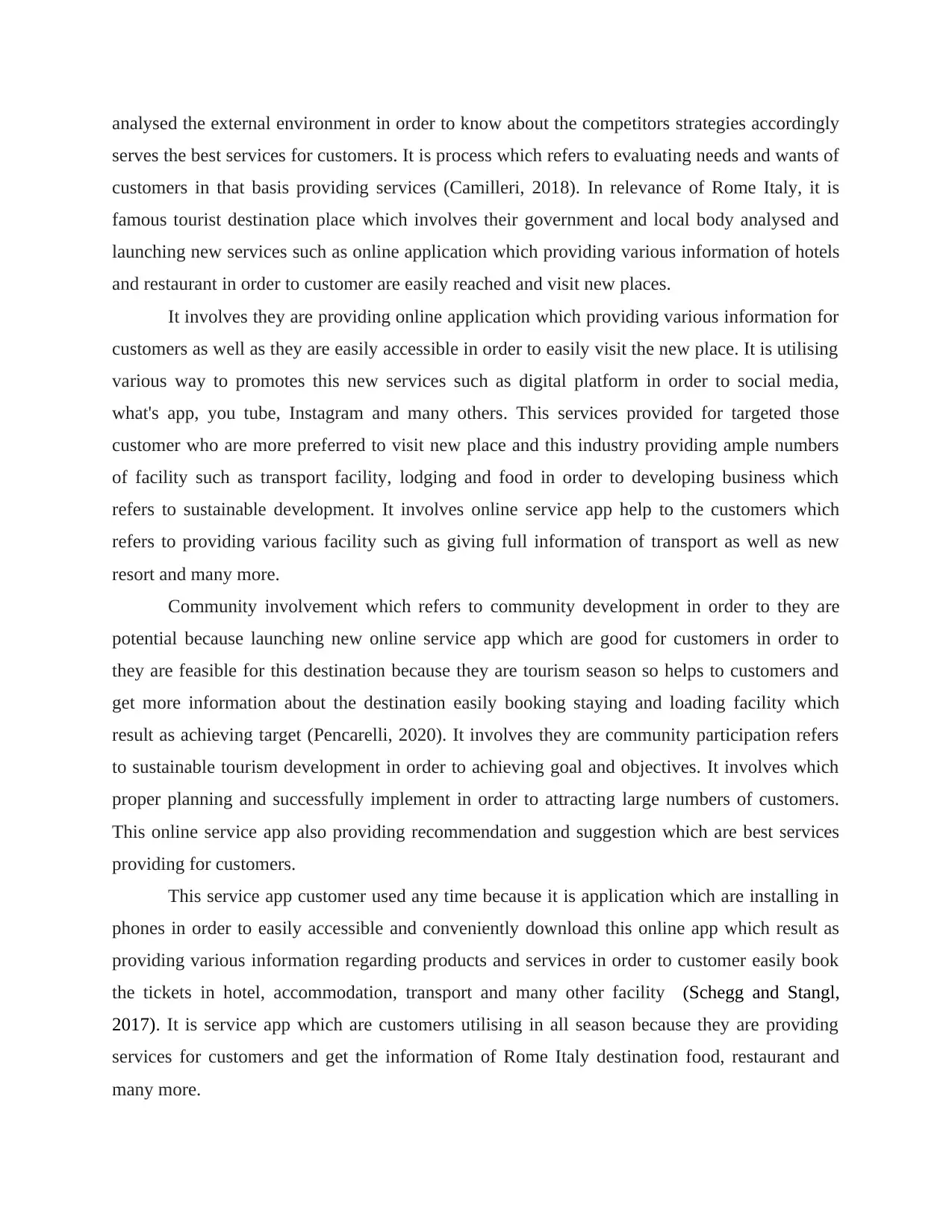
analysed the external environment in order to know about the competitors strategies accordingly
serves the best services for customers. It is process which refers to evaluating needs and wants of
customers in that basis providing services (Camilleri, 2018). In relevance of Rome Italy, it is
famous tourist destination place which involves their government and local body analysed and
launching new services such as online application which providing various information of hotels
and restaurant in order to customer are easily reached and visit new places.
It involves they are providing online application which providing various information for
customers as well as they are easily accessible in order to easily visit the new place. It is utilising
various way to promotes this new services such as digital platform in order to social media,
what's app, you tube, Instagram and many others. This services provided for targeted those
customer who are more preferred to visit new place and this industry providing ample numbers
of facility such as transport facility, lodging and food in order to developing business which
refers to sustainable development. It involves online service app help to the customers which
refers to providing various facility such as giving full information of transport as well as new
resort and many more.
Community involvement which refers to community development in order to they are
potential because launching new online service app which are good for customers in order to
they are feasible for this destination because they are tourism season so helps to customers and
get more information about the destination easily booking staying and loading facility which
result as achieving target (Pencarelli, 2020). It involves they are community participation refers
to sustainable tourism development in order to achieving goal and objectives. It involves which
proper planning and successfully implement in order to attracting large numbers of customers.
This online service app also providing recommendation and suggestion which are best services
providing for customers.
This service app customer used any time because it is application which are installing in
phones in order to easily accessible and conveniently download this online app which result as
providing various information regarding products and services in order to customer easily book
the tickets in hotel, accommodation, transport and many other facility (Schegg and Stangl,
2017). It is service app which are customers utilising in all season because they are providing
services for customers and get the information of Rome Italy destination food, restaurant and
many more.
serves the best services for customers. It is process which refers to evaluating needs and wants of
customers in that basis providing services (Camilleri, 2018). In relevance of Rome Italy, it is
famous tourist destination place which involves their government and local body analysed and
launching new services such as online application which providing various information of hotels
and restaurant in order to customer are easily reached and visit new places.
It involves they are providing online application which providing various information for
customers as well as they are easily accessible in order to easily visit the new place. It is utilising
various way to promotes this new services such as digital platform in order to social media,
what's app, you tube, Instagram and many others. This services provided for targeted those
customer who are more preferred to visit new place and this industry providing ample numbers
of facility such as transport facility, lodging and food in order to developing business which
refers to sustainable development. It involves online service app help to the customers which
refers to providing various facility such as giving full information of transport as well as new
resort and many more.
Community involvement which refers to community development in order to they are
potential because launching new online service app which are good for customers in order to
they are feasible for this destination because they are tourism season so helps to customers and
get more information about the destination easily booking staying and loading facility which
result as achieving target (Pencarelli, 2020). It involves they are community participation refers
to sustainable tourism development in order to achieving goal and objectives. It involves which
proper planning and successfully implement in order to attracting large numbers of customers.
This online service app also providing recommendation and suggestion which are best services
providing for customers.
This service app customer used any time because it is application which are installing in
phones in order to easily accessible and conveniently download this online app which result as
providing various information regarding products and services in order to customer easily book
the tickets in hotel, accommodation, transport and many other facility (Schegg and Stangl,
2017). It is service app which are customers utilising in all season because they are providing
services for customers and get the information of Rome Italy destination food, restaurant and
many more.
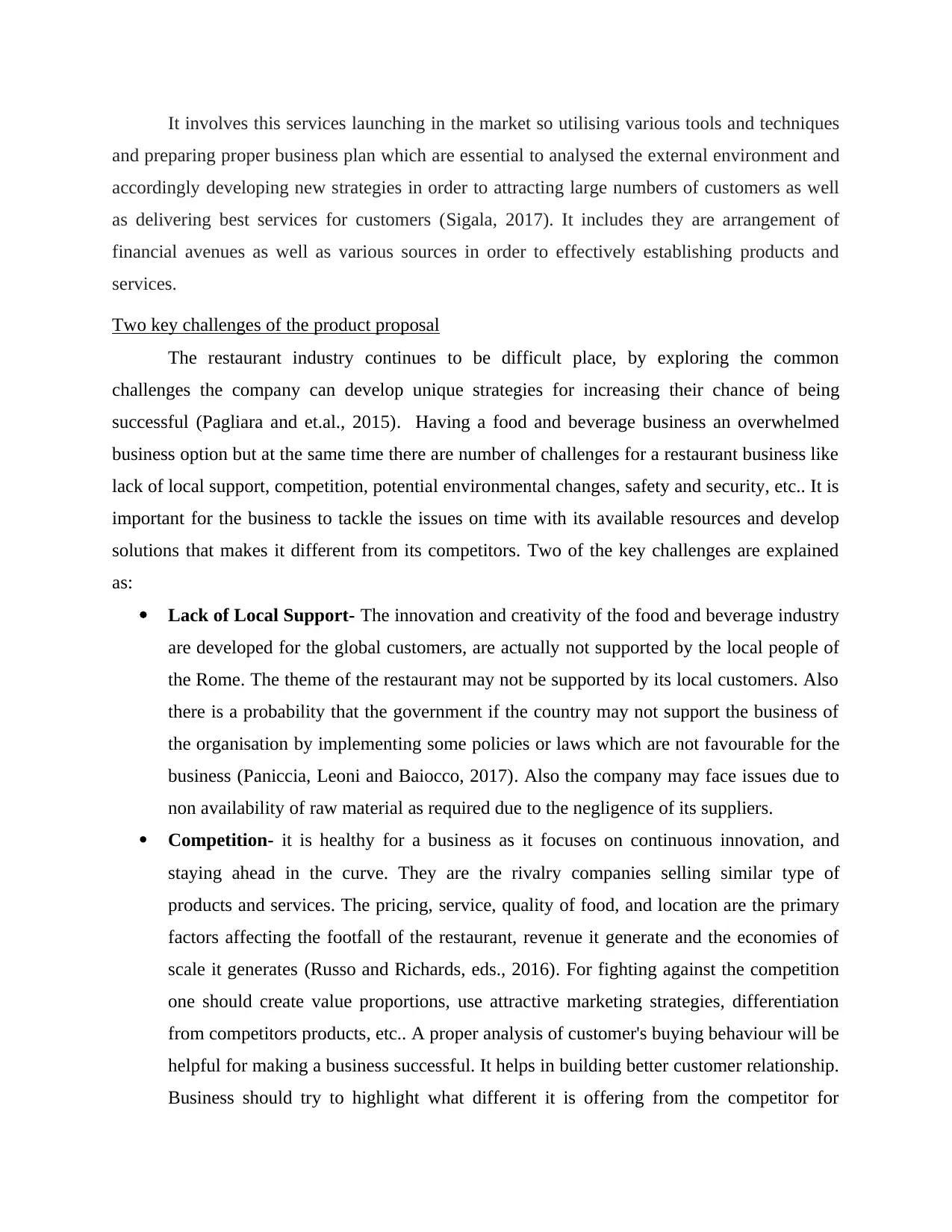
It involves this services launching in the market so utilising various tools and techniques
and preparing proper business plan which are essential to analysed the external environment and
accordingly developing new strategies in order to attracting large numbers of customers as well
as delivering best services for customers (Sigala, 2017). It includes they are arrangement of
financial avenues as well as various sources in order to effectively establishing products and
services.
Two key challenges of the product proposal
The restaurant industry continues to be difficult place, by exploring the common
challenges the company can develop unique strategies for increasing their chance of being
successful (Pagliara and et.al., 2015). Having a food and beverage business an overwhelmed
business option but at the same time there are number of challenges for a restaurant business like
lack of local support, competition, potential environmental changes, safety and security, etc.. It is
important for the business to tackle the issues on time with its available resources and develop
solutions that makes it different from its competitors. Two of the key challenges are explained
as:
Lack of Local Support- The innovation and creativity of the food and beverage industry
are developed for the global customers, are actually not supported by the local people of
the Rome. The theme of the restaurant may not be supported by its local customers. Also
there is a probability that the government if the country may not support the business of
the organisation by implementing some policies or laws which are not favourable for the
business (Paniccia, Leoni and Baiocco, 2017). Also the company may face issues due to
non availability of raw material as required due to the negligence of its suppliers.
Competition- it is healthy for a business as it focuses on continuous innovation, and
staying ahead in the curve. They are the rivalry companies selling similar type of
products and services. The pricing, service, quality of food, and location are the primary
factors affecting the footfall of the restaurant, revenue it generate and the economies of
scale it generates (Russo and Richards, eds., 2016). For fighting against the competition
one should create value proportions, use attractive marketing strategies, differentiation
from competitors products, etc.. A proper analysis of customer's buying behaviour will be
helpful for making a business successful. It helps in building better customer relationship.
Business should try to highlight what different it is offering from the competitor for
and preparing proper business plan which are essential to analysed the external environment and
accordingly developing new strategies in order to attracting large numbers of customers as well
as delivering best services for customers (Sigala, 2017). It includes they are arrangement of
financial avenues as well as various sources in order to effectively establishing products and
services.
Two key challenges of the product proposal
The restaurant industry continues to be difficult place, by exploring the common
challenges the company can develop unique strategies for increasing their chance of being
successful (Pagliara and et.al., 2015). Having a food and beverage business an overwhelmed
business option but at the same time there are number of challenges for a restaurant business like
lack of local support, competition, potential environmental changes, safety and security, etc.. It is
important for the business to tackle the issues on time with its available resources and develop
solutions that makes it different from its competitors. Two of the key challenges are explained
as:
Lack of Local Support- The innovation and creativity of the food and beverage industry
are developed for the global customers, are actually not supported by the local people of
the Rome. The theme of the restaurant may not be supported by its local customers. Also
there is a probability that the government if the country may not support the business of
the organisation by implementing some policies or laws which are not favourable for the
business (Paniccia, Leoni and Baiocco, 2017). Also the company may face issues due to
non availability of raw material as required due to the negligence of its suppliers.
Competition- it is healthy for a business as it focuses on continuous innovation, and
staying ahead in the curve. They are the rivalry companies selling similar type of
products and services. The pricing, service, quality of food, and location are the primary
factors affecting the footfall of the restaurant, revenue it generate and the economies of
scale it generates (Russo and Richards, eds., 2016). For fighting against the competition
one should create value proportions, use attractive marketing strategies, differentiation
from competitors products, etc.. A proper analysis of customer's buying behaviour will be
helpful for making a business successful. It helps in building better customer relationship.
Business should try to highlight what different it is offering from the competitor for

gaining customers attention. Company should try to convey a clear message to its
customers as to what it can do for them that no one else can do (Salata, and et.al., 2017).
This will help in building a strong brand reputation in the mind of the prospective buyers.
CONCLUSION
This report consists of a brief study done on the travel and tourism of Rome, Italy. It is a famous
destination for millennial as it is rich in art and a location for foodie (Dredge and Gyimóthy,
eds., 2017). It is the most visited city from the European countries.
customers as to what it can do for them that no one else can do (Salata, and et.al., 2017).
This will help in building a strong brand reputation in the mind of the prospective buyers.
CONCLUSION
This report consists of a brief study done on the travel and tourism of Rome, Italy. It is a famous
destination for millennial as it is rich in art and a location for foodie (Dredge and Gyimóthy,
eds., 2017). It is the most visited city from the European countries.
Paraphrase This Document
Need a fresh take? Get an instant paraphrase of this document with our AI Paraphraser
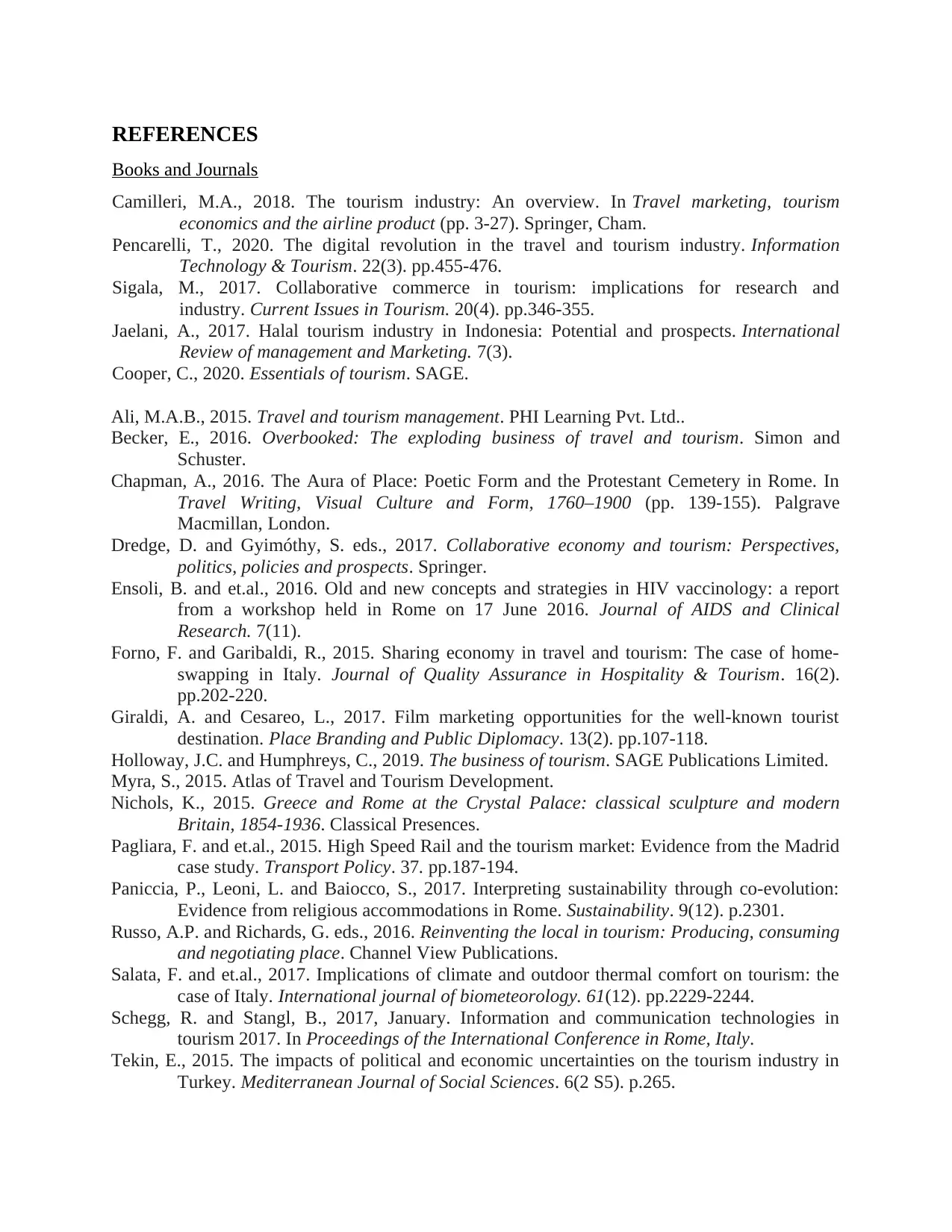
REFERENCES
Books and Journals
Camilleri, M.A., 2018. The tourism industry: An overview. In Travel marketing, tourism
economics and the airline product (pp. 3-27). Springer, Cham.
Pencarelli, T., 2020. The digital revolution in the travel and tourism industry. Information
Technology & Tourism. 22(3). pp.455-476.
Sigala, M., 2017. Collaborative commerce in tourism: implications for research and
industry. Current Issues in Tourism. 20(4). pp.346-355.
Jaelani, A., 2017. Halal tourism industry in Indonesia: Potential and prospects. International
Review of management and Marketing. 7(3).
Cooper, C., 2020. Essentials of tourism. SAGE.
Ali, M.A.B., 2015. Travel and tourism management. PHI Learning Pvt. Ltd..
Becker, E., 2016. Overbooked: The exploding business of travel and tourism. Simon and
Schuster.
Chapman, A., 2016. The Aura of Place: Poetic Form and the Protestant Cemetery in Rome. In
Travel Writing, Visual Culture and Form, 1760–1900 (pp. 139-155). Palgrave
Macmillan, London.
Dredge, D. and Gyimóthy, S. eds., 2017. Collaborative economy and tourism: Perspectives,
politics, policies and prospects. Springer.
Ensoli, B. and et.al., 2016. Old and new concepts and strategies in HIV vaccinology: a report
from a workshop held in Rome on 17 June 2016. Journal of AIDS and Clinical
Research. 7(11).
Forno, F. and Garibaldi, R., 2015. Sharing economy in travel and tourism: The case of home-
swapping in Italy. Journal of Quality Assurance in Hospitality & Tourism. 16(2).
pp.202-220.
Giraldi, A. and Cesareo, L., 2017. Film marketing opportunities for the well-known tourist
destination. Place Branding and Public Diplomacy. 13(2). pp.107-118.
Holloway, J.C. and Humphreys, C., 2019. The business of tourism. SAGE Publications Limited.
Myra, S., 2015. Atlas of Travel and Tourism Development.
Nichols, K., 2015. Greece and Rome at the Crystal Palace: classical sculpture and modern
Britain, 1854-1936. Classical Presences.
Pagliara, F. and et.al., 2015. High Speed Rail and the tourism market: Evidence from the Madrid
case study. Transport Policy. 37. pp.187-194.
Paniccia, P., Leoni, L. and Baiocco, S., 2017. Interpreting sustainability through co-evolution:
Evidence from religious accommodations in Rome. Sustainability. 9(12). p.2301.
Russo, A.P. and Richards, G. eds., 2016. Reinventing the local in tourism: Producing, consuming
and negotiating place. Channel View Publications.
Salata, F. and et.al., 2017. Implications of climate and outdoor thermal comfort on tourism: the
case of Italy. International journal of biometeorology. 61(12). pp.2229-2244.
Schegg, R. and Stangl, B., 2017, January. Information and communication technologies in
tourism 2017. In Proceedings of the International Conference in Rome, Italy.
Tekin, E., 2015. The impacts of political and economic uncertainties on the tourism industry in
Turkey. Mediterranean Journal of Social Sciences. 6(2 S5). p.265.
Books and Journals
Camilleri, M.A., 2018. The tourism industry: An overview. In Travel marketing, tourism
economics and the airline product (pp. 3-27). Springer, Cham.
Pencarelli, T., 2020. The digital revolution in the travel and tourism industry. Information
Technology & Tourism. 22(3). pp.455-476.
Sigala, M., 2017. Collaborative commerce in tourism: implications for research and
industry. Current Issues in Tourism. 20(4). pp.346-355.
Jaelani, A., 2017. Halal tourism industry in Indonesia: Potential and prospects. International
Review of management and Marketing. 7(3).
Cooper, C., 2020. Essentials of tourism. SAGE.
Ali, M.A.B., 2015. Travel and tourism management. PHI Learning Pvt. Ltd..
Becker, E., 2016. Overbooked: The exploding business of travel and tourism. Simon and
Schuster.
Chapman, A., 2016. The Aura of Place: Poetic Form and the Protestant Cemetery in Rome. In
Travel Writing, Visual Culture and Form, 1760–1900 (pp. 139-155). Palgrave
Macmillan, London.
Dredge, D. and Gyimóthy, S. eds., 2017. Collaborative economy and tourism: Perspectives,
politics, policies and prospects. Springer.
Ensoli, B. and et.al., 2016. Old and new concepts and strategies in HIV vaccinology: a report
from a workshop held in Rome on 17 June 2016. Journal of AIDS and Clinical
Research. 7(11).
Forno, F. and Garibaldi, R., 2015. Sharing economy in travel and tourism: The case of home-
swapping in Italy. Journal of Quality Assurance in Hospitality & Tourism. 16(2).
pp.202-220.
Giraldi, A. and Cesareo, L., 2017. Film marketing opportunities for the well-known tourist
destination. Place Branding and Public Diplomacy. 13(2). pp.107-118.
Holloway, J.C. and Humphreys, C., 2019. The business of tourism. SAGE Publications Limited.
Myra, S., 2015. Atlas of Travel and Tourism Development.
Nichols, K., 2015. Greece and Rome at the Crystal Palace: classical sculpture and modern
Britain, 1854-1936. Classical Presences.
Pagliara, F. and et.al., 2015. High Speed Rail and the tourism market: Evidence from the Madrid
case study. Transport Policy. 37. pp.187-194.
Paniccia, P., Leoni, L. and Baiocco, S., 2017. Interpreting sustainability through co-evolution:
Evidence from religious accommodations in Rome. Sustainability. 9(12). p.2301.
Russo, A.P. and Richards, G. eds., 2016. Reinventing the local in tourism: Producing, consuming
and negotiating place. Channel View Publications.
Salata, F. and et.al., 2017. Implications of climate and outdoor thermal comfort on tourism: the
case of Italy. International journal of biometeorology. 61(12). pp.2229-2244.
Schegg, R. and Stangl, B., 2017, January. Information and communication technologies in
tourism 2017. In Proceedings of the International Conference in Rome, Italy.
Tekin, E., 2015. The impacts of political and economic uncertainties on the tourism industry in
Turkey. Mediterranean Journal of Social Sciences. 6(2 S5). p.265.
1 out of 8
Related Documents
Your All-in-One AI-Powered Toolkit for Academic Success.
+13062052269
info@desklib.com
Available 24*7 on WhatsApp / Email
![[object Object]](/_next/static/media/star-bottom.7253800d.svg)
Unlock your academic potential
© 2024 | Zucol Services PVT LTD | All rights reserved.





